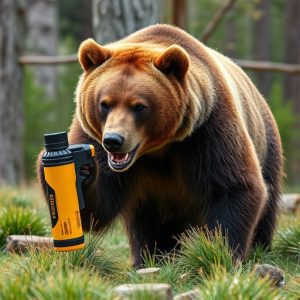Stay Safe: Mastering Bear Protection with Spray and Beyond
Understanding bear behavior is crucial for anyone venturing into bear country, where bear spray is a…….
Understanding bear behavior is crucial for anyone venturing into bear country, where bear spray is an essential deterrent. Capsaicin from chili peppers and other chemicals like tetramethrin and piperidene carboxylic acid (PCA) are key ingredients that irritate bears, providing escape time when used correctly. For optimal protection, select bear spray with these components at recommended concentrations, considering spray pattern, range, and weather resistance. In aggressive bear encounters, apply the spray in a sweeping motion at the bear's face and eyes while maintaining eye contact, following manufacturer instructions for safety and effectiveness. Beyond bear spray, enhanced outdoor safety includes proper food storage, noise-making during hiking, and using a sturdy bear canister, ensuring a secure experience in bear country.
Outdoor enthusiasts and adventurers, be prepared! Navigating the wilderness comes with an understanding of potential risks, especially encounters with aggressive bears. This comprehensive guide delves into effective strategies for outdoor protection. We explore the science behind bear spray, its active ingredients, and how to choose the right one for optimal safety. Learn essential application techniques and discover additional measures to ensure a secure outdoor experience, going beyond just bear spray. Understand aggressive bear behavior and arm yourself with knowledge for peace of mind in nature.
- Understanding Bear Behavior: Recognizing Aggressive Patterns
- The Science Behind Bear Spray: Active Ingredients and Their Efficacy
- Choosing the Right Bear Spray: Factors to Consider for Optimal Protection
- Application Techniques: Maximizing the Impact of Bear Spray During Encounters
- Additional Safety Measures: Enhancing Your Outdoor Experience Beyond Bear Spray
Understanding Bear Behavior: Recognizing Aggressive Patterns
Understanding bear behavior is crucial when venturing into bear country. Bears are typically solitary animals and will usually avoid humans, but certain situations can trigger aggressive responses. Recognizing aggressive patterns can help hikers and campers prevent dangerous encounters. One key indicator of aggression is a bear’s insistence on approaching or following you closely, often accompanied by vocalizations like jaw-popping or clacking teeth.
Bears use scent and sound to communicate, so if a bear shows an interest in your presence, it might be trying to determine if you pose a threat. In such cases, bearing spray (a mixture of capsaicin and other chemicals) can be an effective deterrent. Knowing the active ingredients in bear spray, like capsaicin, which is found in chili peppers, can help hikers make informed decisions about their safety gear.
The Science Behind Bear Spray: Active Ingredients and Their Efficacy
Bear spray, a potent deterrent, has become an essential tool for outdoor enthusiasts navigating bear-inhabited areas. The science behind its effectiveness lies in the active ingredients it contains. These chemicals are designed to create a temporary yet powerful irritation, disorienting and repelling bears. Common active ingredients include capsaicin, a compound derived from chili peppers, and various types of pepper spray. These substances stimulate pain receptors, causing the bear to react by either fleeing or becoming temporarily stunned.
The efficacy of bear spray is backed by numerous studies, demonstrating its ability to reduce aggressive behavior in bears. Research shows that when used correctly, bear spray can effectively deter a charging bear, providing crucial time for escape. What Chemicals Are in Bear Spray is a question often asked by adventurers, who want to understand the tools at their disposal. Beyond capsaicin, some formulations include other irritants like piperidinium chloride and various aromatic compounds, each contributing to the spray’s potency and range.
Choosing the Right Bear Spray: Factors to Consider for Optimal Protection
When selecting bear spray, understanding what chemicals are present is paramount. Effective bear spray formulations typically contain capsaicin, the same chemical found in chili peppers, along with other active ingredients like tetramethrin or piperidene carboxylic acid (PCA). These chemicals work together to deter bears by irritating their eyes and respiratory system. Look for a can that clearly lists these components and specifies their concentrations; higher concentrations generally offer better protection.
Additionally, consider factors such as the spray pattern, range, and weather conditions when choosing bear spray. A can with a wide spray pattern ensures maximum coverage, while a longer range allows you to maintain distance from potential threats. Keep in mind that weather can impact performance; bear spray may be less effective in wet or windy conditions, so opt for products designed to combat these challenges.
Application Techniques: Maximizing the Impact of Bear Spray During Encounters
When faced with an aggressive bear, proper application of bear spray is crucial for maximizing your safety. The effectiveness of bear spray relies on several factors, including wind conditions and distance from the bear. To ensure optimal impact, spray in a sweeping motion at the bear’s face and eyes, creating a dense cloud of mist. Maintain eye contact with the bear throughout the spraying process to ensure it is engaged and affected by the spray. Keep in mind that most bear sprays contain capsaicin, the same chemical found in chili peppers, which irritates the bear’s respiratory system, temporarily disorienting and repelling it.
Understanding what chemicals are in bear spray goes beyond its effectiveness; it also helps you choose the right product for your needs. While many bear sprays use capsaicin as the primary active ingredient, some formulations incorporate additional components like peppermin and other natural oils to enhance their potency and range. Always follow manufacturer instructions regarding usage and safety precautions, including expiration dates and proper storage, to ensure the spray remains effective during an encounter.
Additional Safety Measures: Enhancing Your Outdoor Experience Beyond Bear Spray
When venturing into bear country, going beyond carrying bear spray is a wise decision to enhance your outdoor safety. While bear spray is an effective deterrent, understanding what chemicals are in it can empower you to make informed choices. Active ingredients like capsaicin, oleoresin capsicum, or pyrethrins create a painful and irritant reaction, causing bears to flee.
Additionally, ensuring your food storage is secure, making noise while hiking to avoid surprise encounters, and carrying a sturdy bear canister for discarded food are crucial measures. These safety practices, combined with proper knowledge of bear behavior, contribute to a more enjoyable and secure outdoor experience in areas frequented by aggressive bears.
Understanding bear behavior and knowing how to respond during encounters is crucial for outdoor enthusiasts. Bear spray has proven to be an effective deterrent, with specific chemicals like capsaicin and piperidine providing a safe and powerful defense against aggressive bears. By choosing the right spray, applying it correctly, and combining these measures with other safety practices, individuals can significantly enhance their outdoor experiences in bear country. Remember, knowledge is key when navigating these wild encounters, ensuring both your safety and the preservation of these majestic creatures’ natural habitats.


